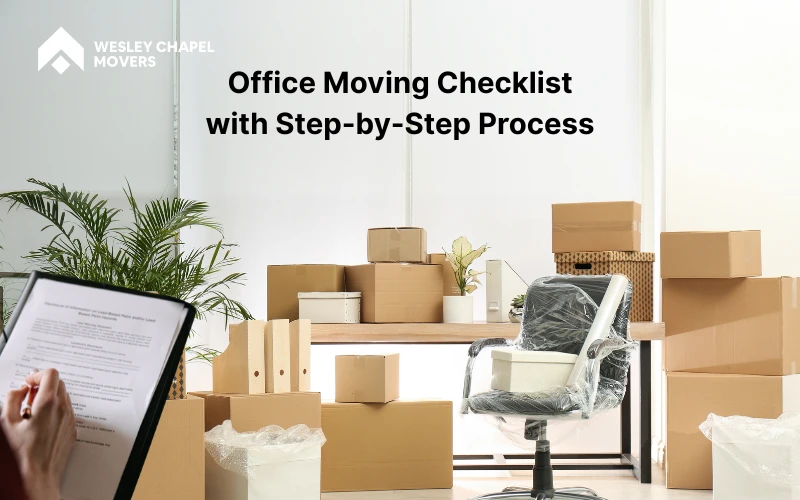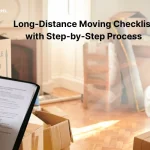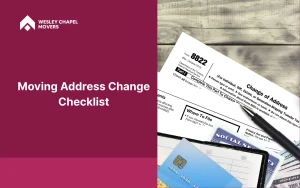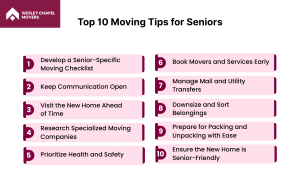When an Office decides to move to a new office, the process can feel overwhelming with all the details that need attention. Whether the move is local or long-distance, having an office moving checklist is crucial for ensuring nothing is overlooked. The checklist helps organize every step, from setting a moving date and booking movers to coordinating utilities and packing materials. By breaking down the tasks into clear, manageable steps, businesses can keep the move on track and reduce the risk of missing critical details.
For local moves, the focus is primarily on logistics such as confirming the moving company, notifying employees, and ensuring utilities are transferred. However, for long-distance moves, additional factors come into play, including transportation, accommodation for moving crews, and ensuring everything arrives safely and on time. The office moving checklist keeps all these moving parts in order, allowing businesses to stay organized, meet deadlines, and minimize disruptions. With everything clearly outlined, the move becomes a structured, manageable process, ensuring a smooth transition into the new office space.
What is an Office Moving Checklist?
An office moving checklist is a structured tool that helps businesses manage every aspect of the relocation process. It organizes tasks and assigns responsibilities, ensuring that all steps are completed in the right order and on time. The checklist acts as a guide from the early stages of planning through to the final setup in the new space, ensuring nothing is missed and the transition is as smooth as possible.
Key tasks typically included in the checklist range from selecting a moving date and notifying employees to hiring moving companies and setting up utilities in the new office. By breaking down tasks into manageable steps, the checklist helps businesses stay on track, minimizing stress and ensuring a well-coordinated move.
Why is an Office Moving Checklist Important?
An office moving checklist is essential for ensuring an efficient, organized, and stress-free relocation. It helps businesses stay on track by breaking down tasks into clear, manageable steps and assigning deadlines to prevent last-minute chaos. From staying organized and reducing stress to tracking progress and managing the budget, the checklist ensures no task is overlooked. It also helps businesses avoid missed tasks, ensures compliance with legal requirements, and ultimately supports a smooth transition into the new office space.
The following key benefits highlight how the checklist plays a crucial role in making the office move successful.
- Staying Organized: Helps organize tasks, ensuring each phase of the move is addressed with a clear timeline and assigned responsibility.
- Reducing Stress: Minimizes the anxiety of the move by breaking down tasks into manageable steps and providing deadlines to avoid last-minute chaos.
- Saving Time: Ensures tasks are completed in the proper order and on time, preventing delays and wasted hours from overlooked details.
- Avoiding Missed Tasks: Prevents critical tasks from being forgotten, such as notifying utilities or setting up IT systems, by keeping everything listed and tracked.
- Tracking Progress: Allows businesses to track the completion of each task, providing visibility on what’s done and what’s left to be done, ensuring the move stays on schedule.
- Helps with Budgeting: Assists in managing costs by tracking expenses for each task, from moving supplies to hiring movers, ensuring the move stays within budget.
- Ensures a Smooth Transition: By ensuring all tasks are completed on time, the checklist ensures that the business can transition to the new space with minimal disruption.
- Preventing Last-Minute Rush: With everything planned in advance, businesses avoid rushed tasks, preventing unnecessary stress and errors as the move approaches.
- Legal and Compliance Issues: Helps businesses stay compliant with legal requirements, such as lease agreements and regulatory notifications, by including these tasks in the checklist.
What is Included in an Office Moving Checklist?
An office moving checklist includes a detailed list of tasks and responsibilities to ensure a smooth relocation. It covers key activities such as setting the moving date, notifying employees, organizing packing, hiring moving companies, and setting up the new office space. The checklist is organized by phases, with tasks to be completed 6–12 months before the move, 2–3 months before, 1 month before, and on moving day itself. These phases involve tasks like confirming moving company details, reviewing lease terms, coordinating IT setup, and managing utility transfers, ensuring that every aspect of the move is planned and executed efficiently.
Step 1: 6-12 Months Before the Move
Set a Moving Date
Choosing a moving date early sets the foundation for booking movers, notifying employees, and aligning the end date of your lease. The move date ensures that you have enough time to handle the packing, vendor coordination, and setup at the new office.
Notify Key Stakeholders
Informing employees, management, and external vendors about the move well in advance allows time for employees to prepare, vendors to adjust schedules, and necessary services like IT setup to be arranged. Clear communication prevents disruptions during the transition.
Create a Moving Budget
A moving budget helps control costs and avoid unexpected expenses. Generally, a moving budget includes expenses like moving company fees, packing materials, and insurance. Having a budget in place ensures that your move stays on track financially and that all necessary costs are covered without surprises.
Research and Select a Moving Company
Selecting a reliable moving company early is key to a smooth transition. Research companies that specialize in office moves, check their reviews, and compare quotes. Confirm the details like timing and equipment handling to ensure the company can meet your office’s specific moving needs.
Review Lease Terms
Reviewing your current lease is essential before committing to a move. Ensure that the lease has provisions for termination and move-out processes to avoid penalties. If you’re moving to a new office, verify that the lease terms align with your business requirements, ensuring a smooth transition.
Consider Insurance
Insurance is critical when moving office equipment. Ensure coverage for potential damages to property and liability during the move. This protects your assets, such as electronics and furniture, and ensures that you’re financially covered if anything goes wrong during the relocation.
Assess Office Equipment & Supplies
Assess your office equipment and supplies to decide what needs to be replaced or repaired before the move. Take inventory of furniture, electronics, and other assets to ensure only necessary items are relocated. This process minimizes unnecessary packing and ensures the smooth transport of essential items.
Step 2: 2-3 Months Before the Move
Finalize the New Office Lease and Terms
Finalize the lease for the new office well in advance to ensure that move-in dates, rent, and property clauses are clearly defined. Confirm all details of the lease agreement to avoid surprises later. This step ensures that the new office is ready for occupancy and eliminates any last-minute issues.
Confirm Moving Company Details
Confirm all logistics with the moving company, including arrival times, crew size, and any special handling requirements. Double-check that the company has all relevant information, such as the office layout and items to be moved, ensuring a smooth execution on moving day.
Notify Utility Providers
Notify utility providers like electricity, gas, and internet companies in advance to ensure that services are transferred or activated at the new office on time. This will avoid delays in settling into the new space and ensure all utilities are ready for use on moving day.
Order Packing Materials
Order packing materials ahead of time, including boxes, bubble wrap, and labels. This ensures that you have everything needed to pack your office supplies and equipment safely. Early ordering helps avoid delays and ensures the packing process is organized.
Develop a Packing Plan
Develop a packing plan to ensure that packing is systematic and efficient. Start with non-essential items, leaving critical equipment and supplies for closer to the move. Organize tasks and assign responsibilities to avoid confusion and ensure a smooth packing process.
Notify Employees of Responsibilities
Inform employees of their specific responsibilities during the move, such as packing personal items or updating contact information. Clear communication ensures that everyone is prepared and aware of their role, helping the move stay on schedule.
Review IT Setup
Work with your IT team to confirm that all systems, such as servers, phone lines, and internet connections, are ready for the new office. Ensure that all data is backed up to avoid any disruptions during the transition. Proper IT setup is crucial for a smooth move and continued business operations.
Notify Partners, Affiliates, and Service Providers
Notify external partners, affiliates, and service providers about the move well in advance. This ensures they are prepared for address changes, updated contracts, or any service interruptions. Timely notification helps maintain strong business relationships and ensures smooth ongoing operations.
Team Meeting to Notify Employees
Hold a team meeting to brief employees about the upcoming move. Use this time to discuss their responsibilities, address any concerns, and ensure everyone is aligned on the move’s timeline. A well-informed team will make the move process more efficient and reduce confusion.
Step 3: 1 Month Before the Move
Confirm Final Details with Movers
One month before the move, it’s crucial to confirm all details with the moving company. This includes verifying the scheduled moving date, confirming the crew size, and ensuring the company understands specific office needs, such as handling sensitive equipment. Finalizing these details prevents any last-minute confusion on the moving day and ensures a smooth relocation process.
Pack and Label Items
Proper packing and labeling are essential for an efficient office move. Start packing items by category, such as files, office supplies, and equipment, and label each box clearly with its contents and designated room. This ensures that items are unpacked in the right areas, making the transition to the new office seamless and organized.
Update Address with Relevant Parties
Update your address with key parties like vendors, clients, and service providers to avoid communication issues. Inform banks, suppliers, and any other external contacts about the office address change well in advance. This ensures that mail, deliveries, and service communications reach the correct location without disruption.
Finalize Office Layout
Finalize the layout of the new office space ahead of the move. Plan where desks, IT equipment, and meeting rooms will be located to streamline the unpacking process. A well-planned office layout will save time during the move and help employees settle in quickly once they arrive at the new office.
Coordinate with Building Management
Coordinating with building management is crucial for a smooth office move. Confirm details such as elevator scheduling, designated parking spots for the moving trucks, and hours of operation for the building. This ensures that you have the necessary access and avoids delays on moving day.
Create Inventory of Office Furniture and Equipment
Creating an inventory of your office furniture and equipment ensures that nothing is left behind or misplaced. List every item, its condition, and its new location in the office. This inventory helps with organization and ensures that any damaged or outdated items are identified before the move.
Sell or Donate Unneeded Items
Declutter by selling or donating office items that are no longer needed. Evaluate your furniture, electronics, and supplies to determine what can be disposed of. This not only reduces the number of items to move but also contributes to sustainability, making your office relocation more efficient and environmentally friendly.
Arrange Cleaning Services for Old and New Office
Arrange for cleaning services at both the old and new office spaces to ensure a fresh start. Clean and disinfect the old office to avoid leaving behind any clutter, and ensure the new office is ready for employees. A clean space will help employees feel more comfortable and prepared for their first day in the new location.
Step 4: Moving Day
Confirm All Vendors and Times for the Move
Confirm all vendor schedules ahead of moving day, including the moving company, IT service providers, and cleaners. Verify their arrival times and ensure they are fully prepared to handle their tasks on schedule. This helps to avoid delays and ensures everything runs smoothly as planned.
Ensure All Boxes Are Labeled
Make sure that every box is labeled with both its contents and the room it belongs to in the new office. Clear labeling helps the movers and staff efficiently unpack and place items in the correct areas, saving time and avoiding confusion during the setup in the new space.
Coordinate with Movers for Loading and Unloading
Coordinate with the moving company to ensure the efficient loading and unloading of office items. Organize the order of loading to prevent damage and confusion. Ensure movers know where each item needs to go in the new office for quick and organized setup.
Change Locks and Access Codes
After the move, change all locks and access codes for the new office to enhance security. This final step ensures that only authorized personnel can enter the building, protecting company assets and sensitive information from unauthorized access.
Employee Checklist
Provide employees with a checklist for moving day, covering essential tasks like packing personal items, labeling boxes, and checking off completed tasks. This helps ensure everyone is on the same page and all personal responsibilities are addressed, making the transition smoother for everyone.
Check Inventory
Conduct a final inventory check to verify that everything is packed and ready for transport. Cross-reference the items with your inventory list to make sure nothing is left behind. This step ensures that all office equipment and supplies are accounted for before the move begins.
Step 5: Unpacking and Setup
Set Up IT Systems
Setting up IT systems is critical for office functionality. Begin by installing and configuring computers, phones, and network systems to ensure employees have access to necessary resources. Double-check all devices are connected to the network and test system functionality to avoid delays in productivity.
Stock Supplies and Organize Office Areas
Stock office supplies, such as stationery and tech equipment, and organize them into designated areas. Set up workstations with the necessary tools for productivity, ensuring that everything employees need is easily accessible. Proper organization promotes a smooth workflow and a clutter-free workspace.
Post-Move Cleaning
Ensure the office space is thoroughly cleaned before setting everything up. If any construction or remodeling took place, schedule a deep cleaning to prepare the floors, windows, and surfaces. A clean office ensures a welcoming environment and makes the setup process more efficient.
Test IT Systems
Test all IT systems, including computers, phones, and network connections, to ensure they’re fully operational before employees start working. Troubleshoot any issues to ensure systems are running smoothly, preventing delays in work and ensuring employees have seamless access to resources.
Set Up Internal Contact List
Create an internal contact list to streamline communication within the office. Include key personnel, department heads, and external contacts for quick access. This ensures everyone can communicate efficiently and resolve any issues promptly during the transition into the new office.
Press Release About the Move
Draft and distribute a press release to inform external stakeholders, such as clients, partners, and the public, about the office move. Highlight key details like the new address and explain how the move will benefit business operations. This helps maintain transparency and ensures everyone is informed.
Step 6: Settling In
Employee Orientation
Conducting an employee orientation is crucial for a smooth transition into the new office. Use this time to introduce employees to the office layout, safety procedures, and any new systems or technologies. A clear orientation helps employees feel comfortable and informed, ensuring they can start working efficiently from day one.
New Office Tour
A comprehensive office tour helps employees familiarize themselves with key areas like the kitchen, restrooms, meeting rooms, and emergency exits. This allows them to settle in quickly and understand where everything is located, promoting a smoother and more productive work environment.
Celebrate with an Office-Warming Event
Hosting an office-warming event helps foster team bonding and makes employees feel welcomed in the new space. Organize a gathering with food and drinks to celebrate the move, giving employees a chance to relax, socialize, and build connections in the new office environment.
Best Practices for Using an Office Moving Checklist
To ensure a smooth office move, personalize your checklist to reflect specific tasks like IT setup and employee-related duties. Prioritize tasks by urgency, addressing the most time-sensitive ones first. Regularly update the checklist as tasks are completed and new ones arise to stay on track. Breaking larger tasks into smaller steps makes them more manageable and reduces overwhelm. Following these best practices will help you stay organized, avoid last-minute issues, and ensure a successful move without chaos.
- Personalize the Checklist
Tailor your checklist to your office’s needs, adding sections for IT setup, packing, or specialized movers. Customization ensures no task is missed, streamlining the move.
- Prioritize Tasks
Focus on urgent tasks first, such as hiring movers or notifying utilities, to prevent last-minute issues and ensure a smooth transition.
- Update the Checklist Regularly
Keep the checklist updated as tasks are completed or new ones arise to stay on track and adjust to any changes during the move.
- Break Tasks into Manageable Steps
Break larger tasks into smaller steps, like “pack documents” or “schedule IT setup,” to stay organized and make steady progress.
Ensure a Smooth Move with the Right Office Moving Checklist
An office moving checklist is key to a smooth relocation, helping you stay organized and on track. It covers tasks, timelines, and ensures nothing is overlooked. Download our checklist to manage everything from planning to setup, ensuring a seamless transition. With our commercial moving services handling logistics, packing, and setup, you can focus on your business. Download now for an efficient, stress-free office move.







